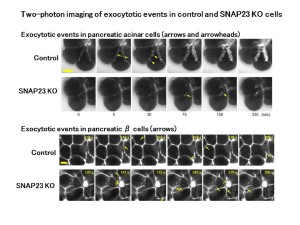Masataka Kunii1,2, Mica Ohara-Imaizumi3, Noriko Takahashi4, Masaki Kobayashi5, Ryosuke Kawakami6, Yasumitsu Kondoh7, Takeshi Shimizu7, Siro Simizu8, Bangzhong Lin9, Kazuto Nunomura9, Kyota Aoyagi3, Mitsuyo Ohno4, Masaki Ohmuraya10, Takashi Sato1, Shin-ichiro Yoshimura2, Ken Sato1, Reiko Harada2,11, Yoon-Jeong Kim9, Hiroyuki Osada7, Tomomi Nemoto6, Haruo Kasai4, Tadahiro Kitamura5, Shinya Nagamatsu3, and Akihiro Harada1,2 1Laboratory of Molecular Traffic, Department of Molecular and Cellular Biology, Institute for Molecular and Cellular Regulation (IMCR), Gunma University 2Department of Cell Biology, Graduate School of Medicine, Osaka University 3Department of Biochemistry, Kyorin University School of Medicine 4Laboratory of Structural Physiology, Center for Disease Biology and Integrative Medicine, Graduate School of Medicine, the University of Tokyo 5Metabolic Signal Research Center, IMCR, Gunma University, Gunma 371-8512, JAPAN 6Laboratory of Molecular and Cellular Biophysics, Research Institute for Electronic Science, Hokkaido University 7Chemical Biology Research Group, RIKEN Center for Sustainable Resource Science 8Department of Applied Chemistry, Faculty of Science and Technology, Keio University 9Drug Discovery Team, Office for University-Industry Collaboration Planning and Promotion, Osaka University 10Institute of Resource Development and Analysis, Kumamoto University 11Department of Judo Therapy, Takarazuka University of Medical and Health Care
About
Newly synthesized secretory proteins, such as hormones and digestive enzymes, are secreted through the fusion of secretory vesicles with the plasma membrane, which is mediated by SNARE proteins. SNAP23 is one of the SNARE proteins, and is involved in exocytotic events in diverse non-neuronal cells. However, the in vivo function of SNAP23 in the fusion of secretory granules remains largely unknown. In this study, we generated pancreatic exocrine- or endocrine-specific Snap23 knockout (KO) mice. The exocrine-specific KO mice showed decreased fusion of zymogen granules, but the endocrine-specific KO mice showed increased fusion of insulin granules and improved glucose tolerance. These results suggest that SNAP23 plays opposite roles in secretion in the exocrine and endocrine pancreas. Furthermore, we found that the SNAP23-binding compound MF286 promoted insulin secretion and improved glucose tolerance by inhibiting formation of the SNARE complex that includes SNAP23. Our study indicated that MF286 may be a candidate drug for diabetes treatment.
Paper information
Masataka Kunii, Mica Ohara-Imaizumi, Noriko Takahashi, Masaki Kobayashi, Ryosuke Kawakami, Yasumitsu Kondoh, Takeshi Shimizu, Siro Simizu, Bangzhong Lin, Kazuto Nunomura, Kyota Aoyagi, Mitsuyo Ohno, Masaki Ohmuraya, Takashi Sato, Shin-ichiro Yoshimura, Ken Sato, Reiko Harada, Yoon-Jeong Kim, Hiroyuki Osada, Tomomi Nemoto, Haruo Kasai, Tadahiro Kitamura, Shinya Nagamatsu, and Akihiro Harada.
Opposing roles for SNAP23 in secretion in exocrine and endocrine pancreatic cells,
The Journal of Cell Biology, Vol.215, No.1, 121-138.2016
Online URL
https://www.ncbi.nlm.nih.gov/pubmed/27697926







